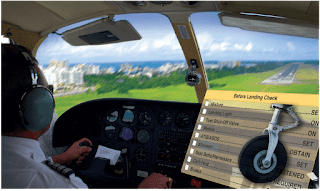Many skills are taught before a learner can fly an airplane or a maintenance learner can rebuild an aircraft engine. Just as practicing scales is a fundamental part of learning to play the piano, the learner does not “make music” until the ability to combine the notes in a variety of ways is acquired. For the learner pilot or technician, practicing specific skills is essential, but flying a cross-country trip or repairing a collapsed landing gear requires “putting it all together” in the right way to achieve success.
The following section looks at the challenge of learning to perform several tasks at once, dealing with distractions and interruptions, overcoming problems with fixation and inattention. It also describes the benefits of using realistic training scenarios to develop these abilities.
The Multitasking Mistake
The term multitasking is often taken for granted to mean handling several tasks at the same time. For example, when a pilot is on approach for a landing it is easy to assume that the experienced pilot is performing tasks in concurrence such as ATC communications, scanning instrumentation, and adjusting for minor deviations through the flight controls.
 |
| A pilot is required to perform several tasks at once during approaches and landings |
We assume that, due to experience and practiced refinement, such skills at some point become automatic and somewhat instinctive. This belief can lead to a false sense of confidence that the routine procedure at hand is only routine and therefore does not require the added attention to question one’s assumption that there will be no deviation in that task. [Figure]
Priorities of Task Management
There is a danger in task switching. The individual may decide that one task is less of a priority than another and choose to postpone resolution of that task. In doing so, it is very easy to simply forget the deferred task completely. Or, should the pilot become momentarily distracted, then effort should be made to remember what task to return to and at what stage of resolution that task was left in. Even the act of managing such tasks is in and of itself a task.
Increased Workload, Diminished Quality
A common response to an overwhelming workload is to reduce the level of standards for quality and achievement. Preemptively evaluating an impending task list to then choose to reduce (or even remove) relatively unimportant tasks can be a safe and effective action against the stresses that often comes with overburdened workload. However, it is not always the case that individuals have the time (or cognitive discipline as referenced in Human Behavior) to accurately predict what tasks should instead be focused on. Sometimes the individual (especially those inexperienced or under high stress) reverts to a reaction-based response process. This can create a negative environment that may actually induce more stress as the individual continually tries to respond to each task without an overall plan.
Learning to Task Manage
Before learners are asked to perform several tasks at once, instructors should ensure that the learner has devoted enough time to study and practice such that the individual tasks can be performed reasonably well in isolation.
Inexperience with an individual task can often hinder attempts to combine it with other tasks. For example, a learner distracted by trying to interpret unfamiliar symbols on a sectional chart inadvertently deviates from assigned attitude or heading. An instructor recognizes the need to spend more time with these skills in isolation. In this case, there is nothing about the experience of controlling the aircraft that helps learners better understand chart symbols.
Distractions and Interruptions
A distraction is an unexpected event that causes the learner’s attention to be momentarily diverted. Learners need to decide whether or not a distraction warrants further attention or action on their part. Once this has been decided, the learners either turn their attention back to what they were doing, or act on the distraction.
An interruption is an unexpected event for which the learner voluntarily suspends performance of one task in order to complete a different one. Interruptions are a significant source of errors and learners need to be aware of the potential for errors caused by interruptions and develop procedures for dealing with them. A classic example is an interruption that occurs while a learner is following the steps in a written procedure or checklist. The learner puts down the checklist, deals with the interruption, and then returns to the procedure—but erroneously picks up at a later point in the procedure, omitting one or more steps.
Fixation and Inattention
Since human attention is limited in focus and highly prone to distraction, people are vulnerable to two other types of problems: fixation and inattention.
Fixation occurs when a learner becomes absorbed in performing one task to the exclusion of other tasks. Instructors see many examples of this in learner performance. Beginning instrument pilots characteristically fixate on particular instruments, attempting to control one aspect of their performance while other aspects deteriorate. Fixation on a task is often a sign that the task has not received enough practice in isolation. That is, the learner has not yet mastered the task well enough to perform it in addition to other tasks. Fixation can happen even when individual skills have been reasonably mastered, when learners have not yet learned the importance of managing their own limited attentional resources.
How to Identify Fixation or Inattention Problems
One way for instructors to identify problems with fixation and inattention is to try and follow where learners look. To accomplish this, instructors can glance at a learner’s eyes to try to determine where they are looking. Learners who appear to look at one instrument for an extended period of time might have a problem with fixation. Learners whose gaze is never directed toward engine instruments might have a problem with inattention.
The technique of following learner eye movements is useful, but has limitations since looking in the same direction is not the same as “seeing” what the learner sees.
